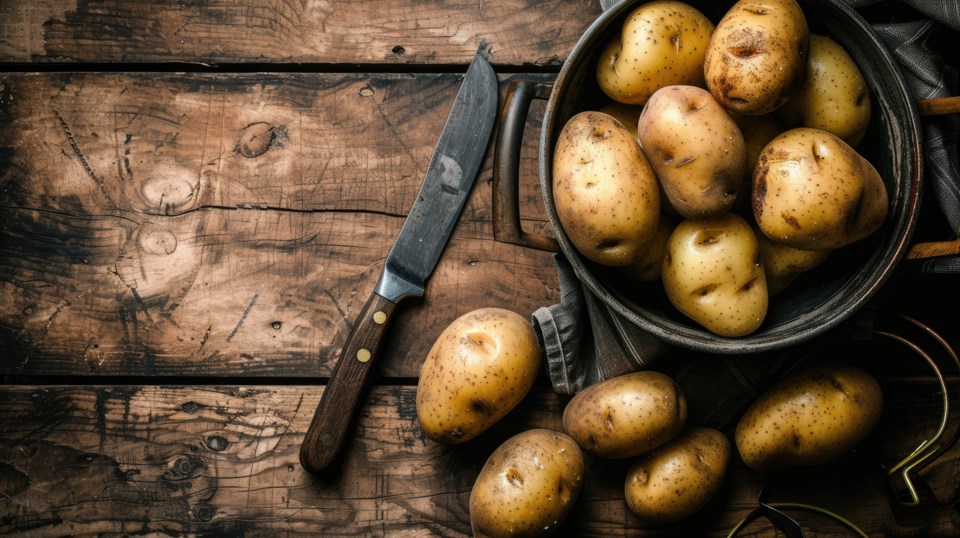One potato, two potatoes, three potatoes, or more. Add them to your diet if you want to score… Score some good nutrition and great fuel, that is. (And whatever else you can, I always say.)
I know—potatoes often get a bad rap when it comes to the diet zone. But it’s usually because of the way they’re often cooked. Like the US Department of Agriculture puts the average Canadian consumption of frozen French fries at seven kilograms per person per year. That’s more than 15 pounds! And those are just the frozen ones. In our household, we eat a lot of good potatoes, ones from our friendly neighbourhood Pemby farmers whenever we can but none of that frozen fried variety.
Were Dag Aabye still amongst us, he’d tell you in a heartbeat what a great nutritional powerhouse potatoes are.
But before I go on about Dag, I have a confession to make: Whenever I encountered him around Whistler back in the early ’80s, say at Tapley’s having a beer, he always kind of scared me. That deep, penetrating gaze, his eyes focused like lasers, never a smile on his face. But maybe that was because I was usually a Whistler Question reporter with a camera pointed at him.
Maybe “scare” is a bit strong, so let me just say that Dag was pretty intense, whatever he was doing. Before his Whistler days, he’d doubled skiing as a stuntman for James Bond, while around town his stunts included jumping off the roof of the cliff-hugging Cheakamus Inn into a pile of powder.
Whistler Museum’s website sports lots of great Dag pix and tales, including the above. But where I first learned about Dag and his Zen understanding of potato power was in Brett Popplewell’s excellent book—Outsider: An Old Man, A Mountain and the Search for a Hidden Past.
If you’ve not discovered it yet, it makes for great summer reading, especially around Whistler. Guaranteed you’ll learn all kinds of things about the legendary Dag Aabye, even if you knew him well. Pick up a copy at my all-time favourite bookstore, Armchair Books, which opened in Village Square in 1982, right around when I was running into Dag.
So here’s how the potato thing goes, at least in part, and even this fragment provides a glimpse into the mindset of this legend, who eventually became famous for his night-time runs—at age 80—on mountain trails illuminated only by his headlamp and maybe the moon, if there was one. Consider the Aabye quote Popplewell uses to open the prologue: “Old people need superheroes too.”
Maybe even more than others do.
In 2002, at 61, Dag was a Canadian championship ski racer, finishing fourth in his age category at Quebec’s Master World Cup cross-country ski race. At the time, he was skinny, malnourished even, living in an old abandoned school bus outside SilverStar ski resort near Vernon. It was the part of his transition from ski whiz to a legendary trail runner and ultra-marathoner.
The following year he ran the gruelling Canadian Death Race, the 128-kilometre (78-mile) foot race through the Rocky Mountains near Grande Cache, Alberta, that’s been held on the August long weekend since 2000. You summit three mountains, cross a major river and face 17,000 feet of elevation change. However far you run, you have to do it in under 24 hours. Dag finished in 20 hours, 58 minutes and 16 seconds. Phew.
He ran that Death Race again and again, until he finally had to settle for the Near Death Marathon, which is about the first half of the Death Race. And much of it was fuelled by potatoes.
Yep, close to home when he was running mountain trails, potatoes powered Dag’s skinny legs. And when he was racing one of those ultramarathons, all he carried with him was a backpack full of boiled potatoes he’d stop and eat mid-way to keep himself fuelled.
Cheap, tasty, good for us. Easy to cook and carry. So what are we all waiting for? Potatoes are amazing.
Like Dag knew, they work hard to fuel our bodies and brains. Potato Goodness says an average potato contains about 110 calories, less than a same-sized banana. It also provides about three grams of protein; about 30 per cent of our daily vitamin C; and lots of vitamin B6 and potassium we need to regulate the electrical signalling in muscles and nerves. While they do have carbs (about 26 grams, or nine per cent of the recommended daily intake), they also help reduce sugar cravings.
The cool thing, and Dag likely felt it first-hand, is if you cook and cool potatoes before eating them, a resistant starch forms that helps our bodies in several ways, including forming short-chain fatty acids that nourish our guts and keep our gut microbiomes healthy. Even sweet potatoes have a lower glycemic index, which can help control weight and appetite.
Bonus: Potatoes are easy on the environment. You need way less water than rice to grow them, and they produce fewer greenhouse gases than both rice and wheat.
As for the USDA estimating the amount of frozen French fries we Canucks eat, it’s all part of them tracking the amount of frozen French fries Canada exports globally versus to America, which is not a significant amount.
Thank goodness for that, or we might see another version of that “freedom fries” revolt Americans took up in 2003, refusing to use the word “French” on signs and menus after France opposed the U.S. invasion of Iraq.
I guess we all know how well that turned out. Bet Dag, superhero for us all, had a good laugh over that.
Glenda Bartosh is an award-winning journalist who loves her Pemberton potatoes.




